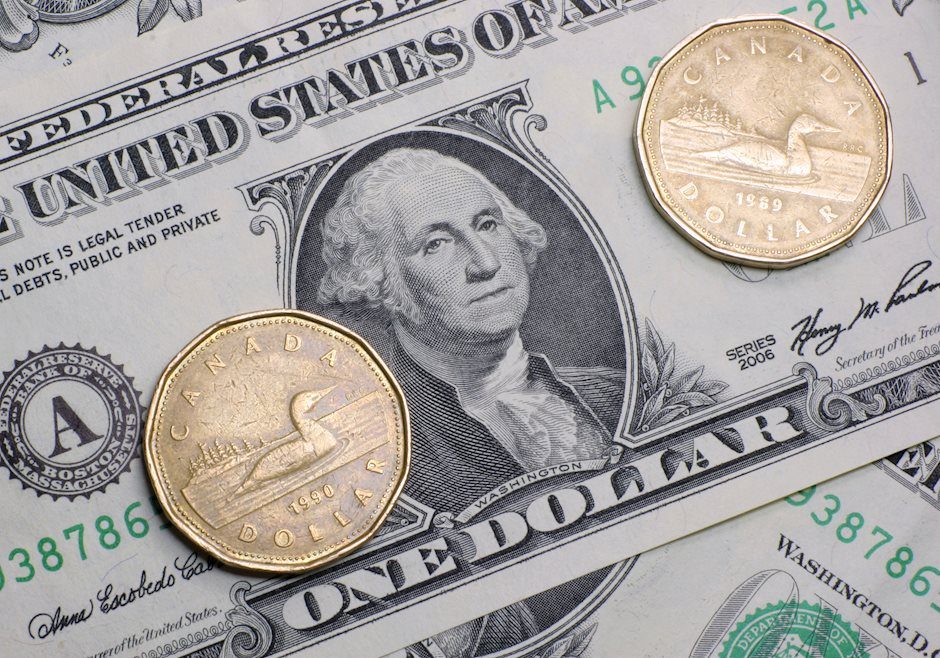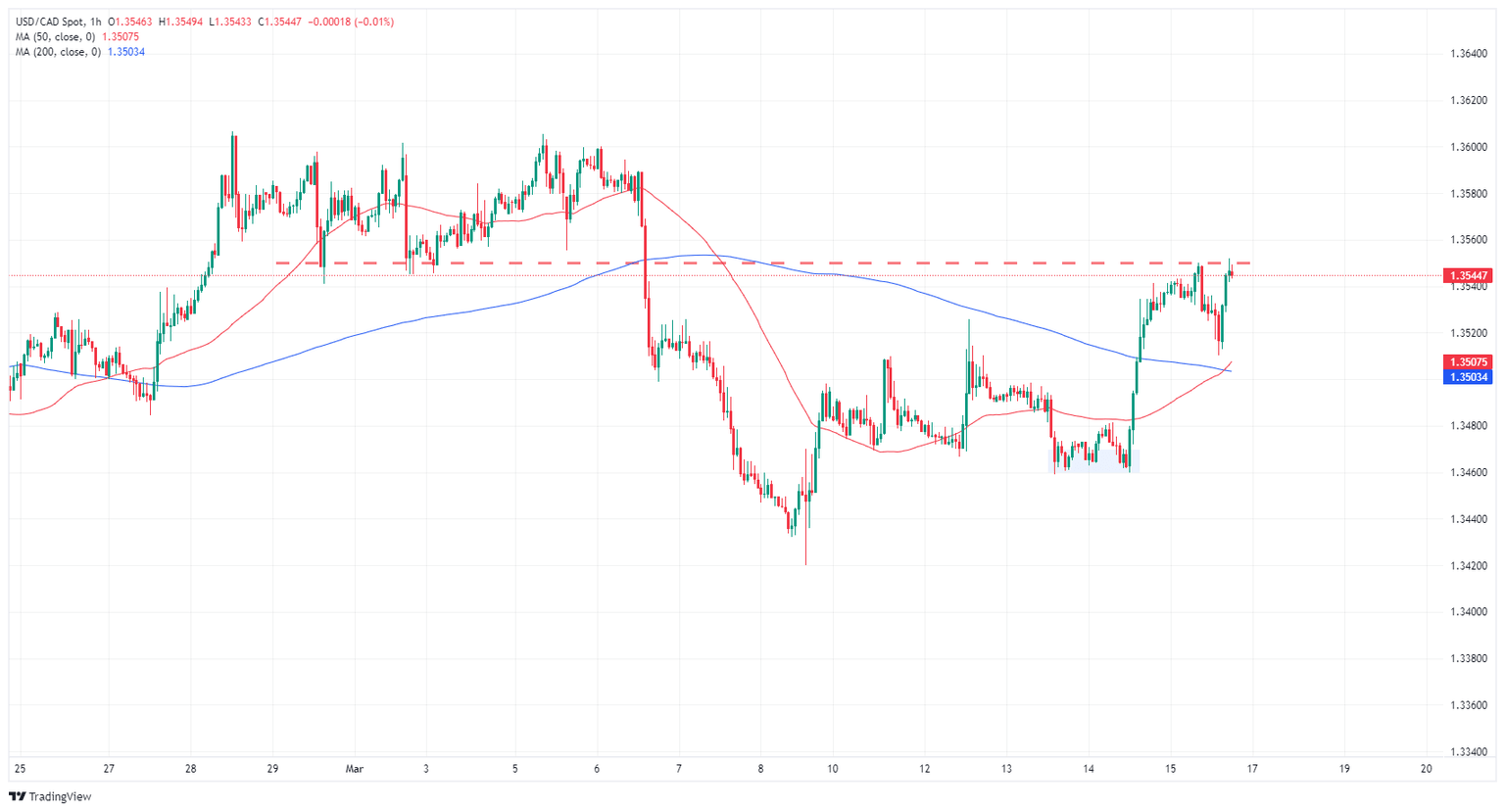Canadian Dollar settles flat against Greenback on Friday as markets buckle down for wait to Fed
- Canadian Dollar is mostly flat on Friday with limited momentum.
- Housing Starts in Canada since November ticked higher.
- Next week: Canadian CPI inflation, US Fed rate call.

The Canadian Dollar (CAD) was mostly higher on Friday but stuck close to the day’s opening range against the US Dollar (USD) as markets shuffled in place ahead of the weekend. The University of Michigan US Consumer Sentiment Index ticked slightly lower early in the American trading session, and the highest print of Canadian Housing Starts since November sailed by without much notice from investors.
Canada brings February’s Consumer Price Index (CPI) inflation figures next week, slated for Tuesday, and markets will be quickly pivoting to face the latest rate statement from the Federal Reserve (Fed) on Wednesday. The Fed will also be updating its Dot Plot projection of interest rate expectations for the next one to five years.
Next week, the latest US Manufacturing Purchasing Managers Index (PMI) will be released on Thursday, followed by Canadian Retail Sales and the US Services PMI component on Friday. Early median market forecasts expect the US Manufacturing PMI to tick slightly lower, and Canadian Retail Sales are expected to contract.
Daily digest market movers: Data drives little chart movement, investors buckle down for the wait to Fed
- Seasonally-adjusted Canadian Housing Starts for the year ending in February rose to 253.5K, easily clearing the forecast of 230K and the previous period’s 223.2K (revised down from 223.6K).
- Canadian Wholesale Sales in January also recovered to a slim 0.1%, bouncing from the forecast of -0.6%. The previous month’s Wholesale Sales were revised to -0.3% from 0.3%. Next-to-flat prints in the revision-prone indicator are unlikely to drive much investor confidence.
- The University of Michigan’s US Consumer Sentiment Index ticked slightly lower in March down to 76.5 versus the market’s forecast hold at the previous 76.9.
- UoM 5-year Consumer Inflation Expectations in March held steady at 2.9% as US consumers remain skeptical that the Fed will successfully drag inflation below 2%.
- US MoM Industrial Production recovered a slim 0.1% in February, snubbing the market’s forecast of 0.0%, but only slightly. The previous month’s Industrial Production was revised down to -0.5% from the initial print of -0.1%.
- Next Tuesday’s Canadian CPI for the year ended February is expected to increase to 3.1% from the previous 2.9%. The Bank of Canada’s (BoC) Core Consumer Price Index (CPI) last came in at 2.4%.
- Canadian Retail Sales are also forecast to contract, with markets expecting a -0.4% print versus the previous 0.9%.
Canadian Dollar price today
The table below shows the percentage change of Canadian Dollar (CAD) against listed major currencies today. Canadian Dollar was the strongest against the .
| USD | EUR | GBP | CAD | AUD | JPY | NZD | CHF | |
| USD | -0.08% | 0.07% | 0.02% | 0.27% | 0.52% | 0.63% | -0.09% | |
| EUR | 0.07% | 0.12% | 0.07% | 0.33% | 0.58% | 0.69% | -0.02% | |
| GBP | -0.07% | -0.13% | -0.06% | 0.19% | 0.45% | 0.56% | -0.15% | |
| CAD | -0.01% | -0.08% | 0.05% | 0.25% | 0.50% | 0.62% | -0.10% | |
| AUD | -0.28% | -0.32% | -0.19% | -0.25% | 0.25% | 0.37% | -0.34% | |
| JPY | -0.52% | -0.57% | -0.44% | -0.51% | -0.29% | 0.10% | -0.60% | |
| NZD | -0.64% | -0.70% | -0.56% | -0.62% | -0.37% | -0.11% | -0.72% | |
| CHF | 0.08% | 0.02% | 0.15% | 0.09% | 0.34% | 0.59% | 0.71% |
The heat map shows percentage changes of major currencies against each other. The base currency is picked from the left column, while the quote currency is picked from the top row. For example, if you pick the Euro from the left column and move along the horizontal line to the Japanese Yen, the percentage change displayed in the box will represent EUR (base)/JPY (quote).
Technical analysis: Flat Friday trading as Canadian Dollar struggles to pare losses against Greenback
The Canadian Dollar (CAD) was mixed to flat on Friday, staying close to the day’s opening range against the US Dollar, Euro (EUR), and Swiss Franc (CHF). The CAD has climbed around a tenth of a percent against the Pound Sterling (GBP) and is up roughly half a percent against the Japanese Yen (JPY).
Intraday trading in the USD/CAD is stuck on the high side of 1.3500, with the day’s early high near 1.3550 and sellers failing to push the pair back below 1.3510. A near-term supply zone is pricing in a potential pullback floor near 1.3460, and intraday bids are struggling to pierce a support-turned-resistance level near 1.3550.
USD/CAD hourly chart

Canadian Dollar FAQs
The key factors driving the Canadian Dollar (CAD) are the level of interest rates set by the Bank of Canada (BoC), the price of Oil, Canada’s largest export, the health of its economy, inflation and the Trade Balance, which is the difference between the value of Canada’s exports versus its imports. Other factors include market sentiment – whether investors are taking on more risky assets (risk-on) or seeking safe-havens (risk-off) – with risk-on being CAD-positive. As its largest trading partner, the health of the US economy is also a key factor influencing the Canadian Dollar.
The Bank of Canada (BoC) has a significant influence on the Canadian Dollar by setting the level of interest rates that banks can lend to one another. This influences the level of interest rates for everyone. The main goal of the BoC is to maintain inflation at 1-3% by adjusting interest rates up or down. Relatively higher interest rates tend to be positive for the CAD. The Bank of Canada can also use quantitative easing and tightening to influence credit conditions, with the former CAD-negative and the latter CAD-positive.
The price of Oil is a key factor impacting the value of the Canadian Dollar. Petroleum is Canada’s biggest export, so Oil price tends to have an immediate impact on the CAD value. Generally, if Oil price rises CAD also goes up, as aggregate demand for the currency increases. The opposite is the case if the price of Oil falls. Higher Oil prices also tend to result in a greater likelihood of a positive Trade Balance, which is also supportive of the CAD.
While inflation had always traditionally been thought of as a negative factor for a currency since it lowers the value of money, the opposite has actually been the case in modern times with the relaxation of cross-border capital controls. Higher inflation tends to lead central banks to put up interest rates which attracts more capital inflows from global investors seeking a lucrative place to keep their money. This increases demand for the local currency, which in Canada’s case is the Canadian Dollar.
Macroeconomic data releases gauge the health of the economy and can have an impact on the Canadian Dollar. Indicators such as GDP, Manufacturing and Services PMIs, employment, and consumer sentiment surveys can all influence the direction of the CAD. A strong economy is good for the Canadian Dollar. Not only does it attract more foreign investment but it may encourage the Bank of Canada to put up interest rates, leading to a stronger currency. If economic data is weak, however, the CAD is likely to fall.
Author

Joshua Gibson
FXStreet
Joshua joins the FXStreet team as an Economics and Finance double major from Vancouver Island University with twelve years' experience as an independent trader focusing on technical analysis.

















